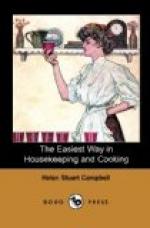Where fruit cake is to be made, raisins should be stoned and chopped, and currants washed and dried, the day beforehand. A cup of currants being a nice and inexpensive addition to buns or any plain cake, it is well to prepare several pounds at once, drying thoroughly, and keeping in glass jars. Being the very dirtiest article known to the storeroom, currants require at least three washings in warm water, rubbing them well in the hands. Then spread them out on a towel, and proceed to pick out all the sticks, grit, small stones, and legs and wings to be found; then put the fruit into a slow oven, and dry it carefully, that none may scorch.
In baking, a moderate oven is one in which a teaspoonful of flour will brown while you count thirty; a quick one, where but twelve can be counted.
The “cup” used in all these receipts is the ordinary kitchen cup, holding half a pint. The measures of flour are, in all cases, of sifted flour, which can be sifted by the quantity, and kept in a wooden pail. “Prepared flour” is especially nice for doughnuts and plain cakes. No great variety of receipts is given, as every family is sure to have one enthusiastic cake-maker who gleans from all sources; and this book aims to give fuller space to substantials than to sweets. Half the energy spent by many housekeepers upon cake would insure the perfect bread, which, nine times out of ten, is not found upon their tables, and success in which they count an impossibility. If cake is to be made, however, let it be done in the most perfect way; seeing only that bread is first irreproachable.
SPONGE CAKE.
One pound of the finest granulated, or of powdered, sugar; half a pound of sifted flour; ten eggs; grated rind of two lemons, and the juice of one; and a saltspoonful of salt.
Break the eggs, yolks and whites separately, and beat the yolks to a creamy froth. Beat the whites till they can be turned upside down without spilling. Put yolks and whites together, and beat till blended; then add the sugar slowly; then the lemon rind and juice and the salt, and last the flour. Whisk together as lightly and quickly as possible. Turn into either three buttered bread-pans of the size given on p. 201, or bake in a large loaf, as preferred. Fill the pans two-thirds full, and, when in the oven, do not open it for ten minutes. Bake about half an hour, and test by running a clean broom-straw into the loaf. If it comes out dry, they are done. Turn out, and cool on a sieve, or on the pans turned upside down.
ROLLED JELLY CAKE.
Three eggs, yolks and whites beaten separately; one heaped cup of sugar; one scant cup of flour in which a teaspoonful of baking powder and a pinch of salt have been sifted; quarter of a cup of boiling water.
Mix as in sponge cake; add the water last, and bake in a large roasting-pan, spreading the batter as thinly as possible. It will bake in ten minutes. When done, and while still hot, spread with any acid jelly, and roll carefully from one side. This cake is nice for lining Charlotte-Russe molds also. For that purpose the water may be omitted, its only use being to make the cake roll more easily.




